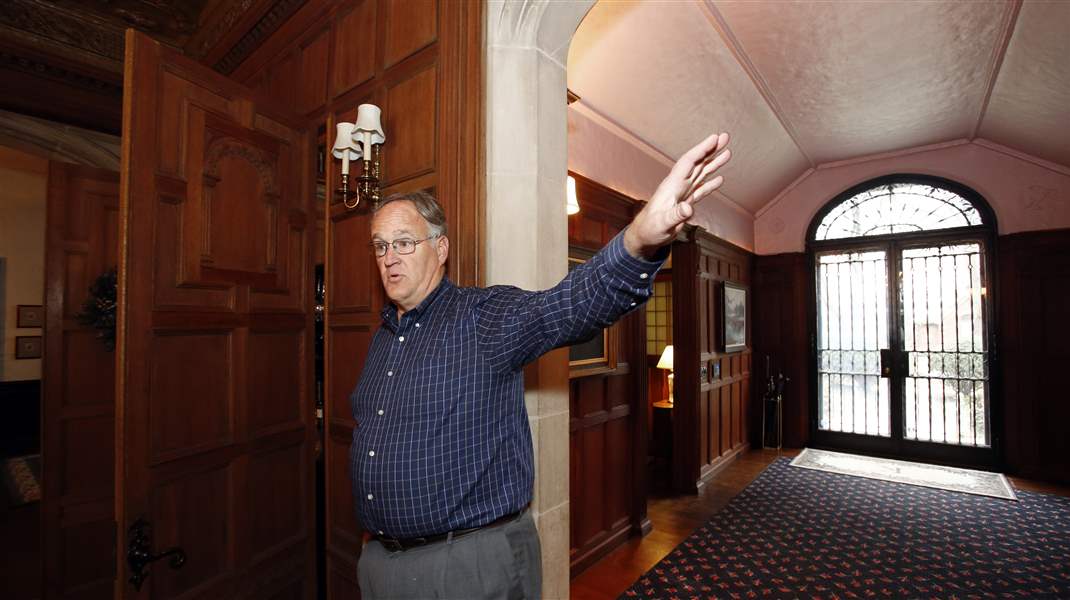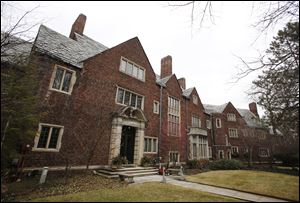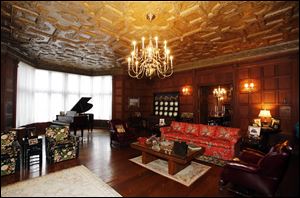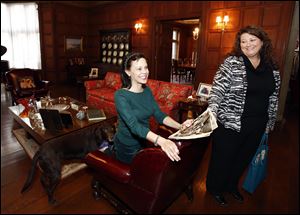
Bidders have chance to grab keys to historic local mansion
1920s George Ross Ford estate to go up for auction in June
3/18/2013
Tony Knight, a great nephew of the builder, says his portion of the Jacobean Revival style mansion has 13,000 square feet.
The Blade/Jeremy Wadsworth
Buy This Image

Exterior of the The George Ross Ford estate, built in the 1920s in Perrysburg. The home is going up for auction.
The George Ross Ford mansion is a home of excess.
But oh, what beautiful excess.
From its Gatsbian pool and gardens to the enormous formal dining room with space for nearly 40, the home exemplifies the unrestrained grandeur shown by Toledo’s captains of industry in the early 1900s — men who built huge estates as monuments to their own success.
And now a part of it could be yours.
The center section of the Perrysburg Township home — the mansion was split into three separate residences in the mid-1970s — will sell to the highest bidder June 15.
Auctioneer Beth Rose said it’s a rare opportunity to buy into one of the most historic homes in northwest Ohio.
“This property probably will not come available again for a very, very long time,” Ms. Rose said. “This isn't something someone lives in a few years and sells. It’s something they keep a lifetime.”
The home was originally built for George Ross Ford, son of the founder of the Edward Ford Plate Glass Co. and the city of Rossford.
The home passed to his son before spending a short time out of the family.
Since the early 1970s, the home has been in the hands of Toledo businessman Tony Knight — a great nephew of the original builder.
It was Mr. Knight who divided the home into three sections. He also helped to develop The Hamlet subdivision, of which the George Ross Ford home is the anchor.
Mr. Knight and wife, Debbie, kept the center section, which is the largest of the three.
“It’s a great home,” Mr. Knight said during a recent tour of the property. “There are lots of interesting elements to this house you would not see in construction today.”
The home has end-cut oak paneling throughout much of the first floor. The plaster ceiling is laid much like modern fiber-glass, layer upon layer put together at 45-degree angles for strength.
There’s also the room for a two-story pipe organ that once occupied the home, and a second-story space with curved walls designed to mimic the inside of a ship.
The George Ross Ford home is one of several historic estates along East River Road in Perrysburg Township that were built in the 1920s and 1930s.
It was there on the picturesque banks of the Maumee River that the region’s captains of industry built summer homes and later massive year-round residences.
Most of those homes remain, making it one of the most architecturally significant areas in northwest Ohio.

Music room in the The George Ross Ford estate.
“It’s really the only thing like that. There are some large homes in Ottawa Hills and Westmoreland, but there’s nothing like what’s along East River Road,” said Ted Ligibel, who is the director of the historic preservation program at Eastern Michigan University. “These were like our answer to Newport, Rhode Island, where the large mansions of the wealthy were built.”
Key residence
The George Ross Ford home was the largest among them, and one of the largest homes in all of northwest Ohio.
Originally reported at 20,000 square feet, the home had 57 rooms and 13 fireplaces. The structure also came with a whole lot of locks.
“Here’s how many keys were to the house,” Mr. Knight said, swinging open a series of four panels with hooks for 349 keys. “Isn’t that incredible?”
The Knights’ section includes eight bedrooms, seven full bathrooms, a family room, dining room, library, and in the basement, a billiards room covered floor to ceiling in end-cut oak paneling.
Each of the three sections is its own residence. The properties share a wall, but otherwise are separate and sit on their own property. Inside the home, it’s difficult to tell the property has been split.
Considering the size of the dwelling and the cost of keeping it up, dividing the property made sense, said Jon Orser, secretary of Historic Perrysburg Inc. and a grandson of George Ross Ford.
“I think it’s a good example of adaptive reuse,” he said. “I’m a supporter of preservation and keeping the building in place, and making it into three dwellings was the right thing to do."
George Ross Ford died in 1938, four years before Mr. Orser was born.
However, Mr. Orser does have memories of visiting his grandmother at the estate.
“During my lifetime a lot of the house was shut down, and she lived very simply there, but I do remember we’d have family events there like Thanksgiving and Christmas,” Mr. Orser said.
Mr. Orser said he even learned to swim in the pool on the property.

Debbie Knight and Beth Rose talk about the George Ross Ford estate.
Jacobean Revival
The home is primarily in the Jacobean Revival style, though it features a mixture of architectural styles in an effort to mimic English estates built over a period of a half-century.
Bob Boyd, a former president of Historic Perrysburg, Inc. and author of Perrysburg Historic Architecture, said the area is fortunate to have so many historic homes that are in such good shape.
But according to Mr. Boyd, the George Ross Ford home stands out above the rest.
“It ranks No. 1 in my opinion. Its size is very impressive and it has some beautiful interior ceilings in the middle part. There’s some beautiful stuff in there,” Mr. Boyd said.
The Knights clearly love the home.
It’s where they’ve raised children and have enjoyed grandchildren.
Much of the antique furniture — including the enormous dining room table — came from the home of W.W. Knight, Sr., which once stood nearby.
W.W. Knight was Mr. Knight’s grandfather.
But at 13,000 square feet, the house is big. It’s especially big, they joke, when cleaning.
Mr. Knight says it’s time to downsize and let someone else enjoy the house as it should be enjoyed
“We don’t do as much entertaining anymore, we don’t do the kind of stuff that you want a house like this for,” Mr. Knight said. “This house is a grand home to entertain in.”
They both say they’ll be sad to leave the home, which is northeast of where the Ohio Turnpike crosses East River Road and not far from the W.W. Knight Nature Preserve and Belmont Country Club.
“You’ll miss it for historical reasons, but I’ll miss it for the house itself,” Mrs. Knight said.
Question of timing
And while the timing is right for Mr. and Mrs. Knight, the timing may be right for the market, too.
Describing Toledo’s real estate market as tepid over the last several years could be generous, but real estate agents say the market picked up steam in 2012, including the market for high-end properties.
“That’s been an active part of the market in the last year,” said Brad Crown, president of the Toledo Board of Realtors.

Tony Knight, a great nephew of the builder, says his portion of the Jacobean Revival style mansion has 13,000 square feet.
Data from the board show that 51 northwest Ohio homes sold for at least $500,000 in 2012, a 16 percent increase from 2011. The increase is the largest percentage jump in the seven price categories the board tracks.
In the last 12 months, 20 homes sold that had listing prices at $750,000 or above, and eight sold that were listed at $1 million or above.
One such home was the Lewis House, another large and historic home on East River Road.
The 1928 French Renaissance Revival-style home of 8,300 square feet sold in December for $1.9 million — the highest price paid for a home in northwest Ohio last year. The home had been listed for $2.9 million.
Last week, Mr. Crown said 17 properties in the region were listed at more than $1 million.
“That’s a lot of activity at the high end for little old Toledo, Ohio,” he said.
Ms. Rose isn’t providing an auction estimate for the George Ross Ford home.
“The buyers are going to tell us exactly what it’s worth,” Ms. Rose said. “It’s going to be the best appraisal we have.”
For tax purposes, Wood County appraised the home at $853,200.
County records show the other sections of the house sold most recently for $227,000 in 1989 and $715,000 in 2001.
The Knights say they chose to put the house up for auction in order to better market the home to a broader swath of potential buyers. Ms. Rose said her firm is doing a nationwide targeted marketing campaign.
“There are people who love historical homes that geographically don’t have to live within a certain area,” Ms. Rose said. “So many people have remote businesses or businesses they’re able to work out of home. They just appreciate and love historical properties so much.”
The auction will be simulcast live online, allowing people to bid from practically anywhere.
Mr. Crown, who is not involved in the sale, said the home’s history can help, but its location is a major plus.
“The river is still the premier place to be. You can’t beat a river view. We don’t have million dollar homes on Lake Erie,” he said. “The river is still the river, and that’s the place to be.”
The George Ross Ford house is part of a collection of seven homes on 1,150 acres that is designated a historic district by the National Register of Historic Places.
“I think it’s important to save these old homes,” Mr. Knight said. “I’m a big historic preservation guy, for a number of reasons. They don’t lose their value as a house, and they certainly are important for our history of our community. Going back and understanding where we came from as a community is important.”
Contact Tyrel Linkhorn at: 419-724-6134 or tlinkhorn@theblade.com.